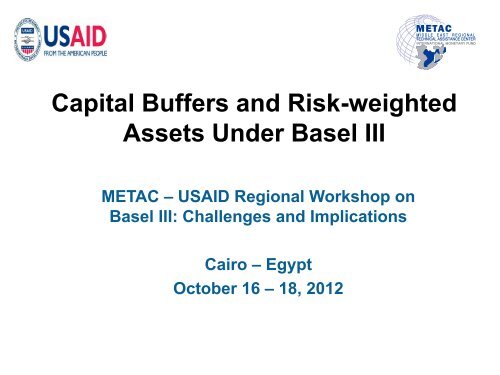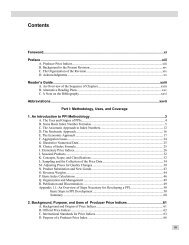Capital Buffers and Risk-weighted Assets Under Basel III - METAC
Capital Buffers and Risk-weighted Assets Under Basel III - METAC
Capital Buffers and Risk-weighted Assets Under Basel III - METAC
- No tags were found...
You also want an ePaper? Increase the reach of your titles
YUMPU automatically turns print PDFs into web optimized ePapers that Google loves.
INTRODUCTION:REFORMS• Overview of the prudential framework after Basle <strong>III</strong>Source: Moodys Analytics1
SOLVENCY RATIO− The solvency ratio is calculated by dividing the bank’scapital by the aggregate of its credit risks (balancesheet <strong>and</strong> off-balance sheet) (estimated in the form of<strong>weighted</strong> exposure - RWA), their operational risks <strong>and</strong>their market risks.− The minimum threshold is equal to 8%.3
CAPITAL STRUCTURE• Ratio’s calibration <strong>and</strong> structureSource : EU FAQ5
CALIBRATION OF THE CAPITALFRAMEWORK• Ratio’s calibration <strong>and</strong> structureSource: BCBS7
CAPITAL BUFFERS• Ratio’s calibration <strong>and</strong> structure− These requirements are supplemented by:• A Conservation Buffer equal to 2.5% of the RWA.• A Countercyclical buffer that may range from 0 % to 2.5% ofthe RWA, such level being determined by national supervisorsaccording to national economic developments. What is thesaid level in Europe?9
CAPITAL CONSERVATION BUFFER• <strong>Capital</strong> conservation buffer: creation of a capitalreserve that can be mobilized in case of crisis• Simple capital conservation rules to avoidbreaches of minimum capital requirements– Level: 2.5% of RWA– CET1– At consolidated level (solo level : national option)– Possibility of applying losses against the said bufferduring a period of stress.11
CAPITAL CONSERVATION BUFFER• The use of the buffer is conditional onrestrictions as regards the payment of dividends<strong>and</strong> bonuses.12
CAPITAL CONSERVATION BUFFER• Reconstitution of the buffer:− Through the reduction of dividend <strong>and</strong> bonuspayments.− Through new issues.− Consultation with the supervisor.− <strong>Capital</strong> plans of banks should seek to rebuild buffersover an appropriate time frame.13
COUNTERCYCLICAL BUFFER• Countercyclical buffer: creation of a capital bufferat the top of the cycle.– Goal: warn the banking system in case of excessivecredit growth.– Supervision of the credit growth <strong>and</strong> other indicators bythe supervisors.14
COUNTERCYCLICAL BUFFER• Main features :– CET1 capital– Set at 0 % in normal times, the national supervisor mayincrease the same to 2.5% of the RWA during creditbubble periods.– May be released when the risk decreases.15
COUNTERCYCLICAL BUFFER• Extension of the capital conservation buffer,utilisation in order to absorb losses in case ofcrisis.− Calculation of the total buffer :• Ex : 2,5 % countercyclical buffer• => CET 1 min = 9,5 %• Total buffer = 5 %• Each quartile of the buffer = 1,25 % CET116
COUNTERCYCLICAL BUFFER• When used, it is accompanied however withrestrictions as regards the distribution ofdividends <strong>and</strong> bonuses.17
COUNTERCYCLICAL BUFFER• Illustration with a 2,5% countercyclical buffer.18
QUESTIONS• What is the principle of the solvency ratio?• What is the required solvency ratio with orwithout a conservation buffer?• When is the countercyclical buffer implemented<strong>and</strong> by whom?• What is the level of the said buffer?19
RISK-WEIGHTED ASSETS• Strengthening of the risk’s coverage:denominator− The inability to value <strong>and</strong> manage risks on thebalance sheet <strong>and</strong> on the off-balance sheet statementas well as the derivative exposure was a keydestabilizing factor during the crisis.− In July 2009, the Basle Committee finalized reforms ofthe Basle II framework concerning market operations<strong>and</strong> complex securitization operations.− While these reforms do not formally form part of theBasle <strong>III</strong> package, they bring a major change to theprudential framework of certain risks <strong>and</strong> are recalledbelow.20
RWA: SECURITIZATIONS• Increased capital requirements in relation tosecuritization operations:− Alignment of the treatment of the trading portfolio’ssecuritizations on that of the banking portfolio’ssecuritizations;− Creation of a minimum retention threshold equal to5% of the economic interests for the originators (« askin in the game ») => grant by upstream banks ofloans of a better quality <strong>and</strong> contribution downstreamto a better monitoring of the receivables once theyhave been securitized;− Tightening of the capital requirements at the level ofthe re-securitizations <strong>and</strong> liquidity lines;− Disclosure requirements.21
RWA: SECURITIZATIONS• The prudential framework related to the banking book’ssecuritization operations is virtually unchangedOriginatingor investingbankSt<strong>and</strong>ardizedapproachInternalratings-basedapproachRatedexposuresUnratedexposuresRatedexposuresUnrated exposuresDeductionABCPsecondlossposition orbetterEligibleliquidityfacilitiesDeductionSupervisoryformula ifcalculationof KIRBpossibleABCPinternalratingmodelEligibleliquidityfacilitiesMappingof externalratings toriskweightsApproachbased onexternalratings22
RWA: SECURITIZATIONS• The prudential framework related to the trading book’ssecuritization operations is materially overhauledCredit derivatives <strong>and</strong> structuredcredit products in the trading bookPrudentialapproachUnsecuritizedcredit products(mainly singlename creditderivatives)Securitized creditproducts<strong>Risk</strong> <strong>and</strong> capitalcalculationTrading bookBanking bookAll unsecuritizedcredit productsNot applicableCorrelationtrading activitiesAll othersecuritized creditproducts23
RWA: MARKET RISKS• Increase in capital requirements related tomarket operations:− <strong>Capital</strong> requirements are the aggregate of the VaR<strong>and</strong> new factors:• stressed VaR– intends to replicate a value-at-risk calculation that would be generatedto the bank’s current portfolio if the relevant market factors wereexperiencing a period of stress with inputs calibrated to historical datafrom a continuous 12-month period of financial stress (for instance,based on the 2007–08 turmoil);• incremental risk capital charge (IRC)– captures default risk as well as migration risk for unsecuritized creditproducts held in the trading book or• comprehensive risk capital charge– limited to so-called correlation trading portfolios <strong>and</strong> captures not onlyincremental default <strong>and</strong> migration risks, but all price risks at a 99.9confidence level on a one-year capital horizon.24
RWA: MARKET RISKS• Market risks (reminder)MARKET RISKSSt<strong>and</strong>ardisedapproachInternal modelGeneral riskSpecific riskif model notapprovedMarket riskfactorsSpecific risk ifmodel approved(if not seest<strong>and</strong>ardisedapproach)25
RWA: MARKET RISKS• St<strong>and</strong>ardized approachSt<strong>and</strong>ardisedapproachGeneralriskSpecific riskif model notapprovedUnchanged,onlyapplicableto someinstrumentsUnsecuritisedcreditexposuresSecuritizedexposuresSt<strong>and</strong>ardizedtreatmentCredit riskapproach forsecuritizationIf correlationtrading, ad hoctreatment26
RWA: MARKET RISKS• Internal model approachesInternalmodelMarketriskfactorsSpecific risk ifmodelapproved (if notseest<strong>and</strong>ardisedapproach)VaRStressedVaRUnsecuritizedcreditexposuresSecuritizedexposuresVaRspecificriskStressedVaRIncrementalrisk chargeCredit riskapproach forsecuritizationCorrelationtradingVaRspecificriskStressedVaRComprehensiverisk capitalchargeSource: Author’s own27
QUESTIONS• What are the three new factors taken into account for thecalculation of the CR in relation to the market risks?• What is the main change affecting the trading book’ssecuritization operations?28
RWA: COUNTERPARTY RISK• Requirements related to the counterparty risksderived from operations involving derivativesCalculation principle−−No requirements related to the banking book’s credit exposuresRequirements concerning the trading book’s OTC exposure• Calculation of the EAD as regards the exposures according to the methodsdetailed in the following slide• Calculation of the counterparty risk in accordance with the IRB credit riskapproach or the institution’s st<strong>and</strong>ard credit risk approach.K = EAD x RW x 8%EAD = exposure at default (IRB) or exposure amount (st<strong>and</strong>ardized approach)RW = risk weight calculated as a function of PD, LGD <strong>and</strong>, in some cases,maturity for IRB approach or with regulatory coefficient for st<strong>and</strong>ardizedapproach.29
RWA: COUNTERPARTY RISK• Counterparty risk: EAD (as an item of information)Current exposure method St<strong>and</strong>ardized method Internal modelling to estimateEADMethod EAD is the currentreplacement cost (RC) morean add-onEAD = RC + add-on<strong>Under</strong> this method, banksmust calculate the currentreplacement cost by markingcontract to market, thuscapturing the currentexposure without any needfor estimation, <strong>and</strong> adding afactor (“the add-on”) to reflectthe potential future exposureover the remaining live of thecontract.Add-on for single name creditderivatives (notional amount xcoefficients set in para 707).See para 708 <strong>Basel</strong> II for n-to-default credit derivativeprudential treatment.EAD is the max of:• the sum of current netmarket value <strong>and</strong>• the sum of absolutevalues of net riskpositions i (notionalamount times modifiedduration) compensatedwith other positions foreach maturity bucket <strong>and</strong>then multiplied by a creditconversion factor (0.3%for credit default swap)Multiplied by a coefficient β=1,4EAD is calculated as theproduct of alpha timeseffective EPE:EAD = α x effective EPEEffective expected positiveexposure is the <strong>weighted</strong>average over time of effectiveexpected exposure over thefirst year (differently ifcontracts mature before oneyear). Therefore banks haveto specify the forecastingdistribution for changes in themarket value to the changesin market variables.α= 1,4 or higher at thediscretion of the supervisor.The use of internal modellingis subject to prior validationby the bank’s supervisor.Source: Author’s own; BCBS30
RWA: COUNTERPARTY RISK• Requirements related to the counterparty risksarisen from derivatives operations:− Must be determined on the basis of stress parameters<strong>and</strong> an increased correlation.• Three years of data including a period of stronger increase ofthe CDS spreads− The contributed guarantees/collateral <strong>and</strong> initialcalculation of the margins are taken into account moreconservatively.• In particular, the banks with material <strong>and</strong> illiquid derivativespositions must apply longer margin calculation periods in orderto calculate regulatory capital requirements.31
RWA: COUNTERPARTY RISK• Counterparty risk (continued)− The banks must also:• regularly check the relevance of their exposure’smeasurement through backtesting;• calculate an additional capital requirement representing therisk of an impairment of the non-defaulting counterparty’scredit quality (credit value adjustments).− corresponds to the mark-to-market losses that have induced losses largelyexceeding the default-related losses during the crisis (2007-2009).• better manage the Wrong Way risk: when exposures increasewhile the counterparty’s credit quality increases.− Incentive fostering reliance on clearing housesthrough lower capital requirements.32
RWA: COUNTERPARTY RISK• Cercle vertueux du traitement des dérivés OTCMoving part oftrading topublic tradingvenuesISDAframeworkbilateralnetting <strong>and</strong>st<strong>and</strong>ardisationStrengtheningthe bilateralcollateralmanagementfor non CCPeligiblecontractsIncreasingtransparency ofprices,transactions<strong>and</strong> positionsMovingclearing ofst<strong>and</strong>ardisedOTC derivativesto CCPsEnhancing theuse of centralrepositories33
SOLVENCY RATIO IMPACT• ImpactSource: BCBS34
SOLVENCY RATIO IMPACT• Solvency ratio in Basle <strong>III</strong>: impact35
HOW TO COPE WITH SUCH NEWREQUIREMENTS ?− Increase of capital:• Issuance of new shares• Profits in reserves− Decrease of the amount of assets <strong>and</strong> risk-<strong>weighted</strong>assets :• Less new loans des nouveaux crédits• Credit portfolio sales• Reallocation of portfolios <strong>and</strong> activities towards less risks.36
QUESTIONS?37
















